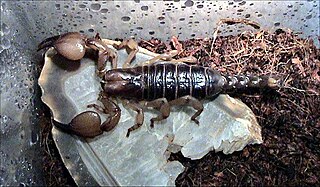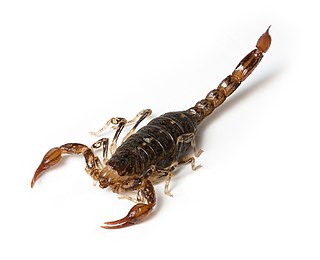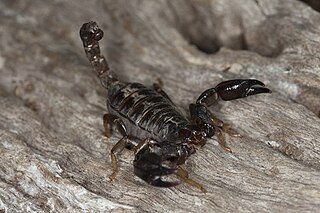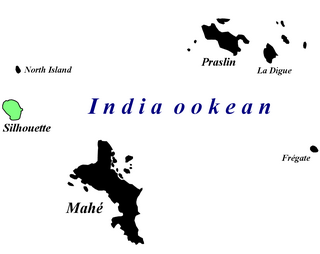
Emil Wilhelm Georg Magnus Kraepelin was a German psychiatrist. H. J. Eysenck's Encyclopedia of Psychology identifies him as the founder of modern scientific psychiatry, psychopharmacology and psychiatric genetics.

Opistophthalmus is a genus of scorpions known commonly as burrowing scorpions, tricolored scorpions, serkets, or hissing scorpions. They are found predominantly in southern Africa. They are known for making deep and elaborate burrows.

The Buthidae are the largest family of scorpions, containing about 100 genera and 1339 species as of 2022. A few very large genera are known, but a high number of species-poor or monotypic ones also exist. New taxa are being described at a rate of several new species per year. They have a [cosmopolitan] distribution throughout tropical and subtropical environments worldwide. Together with four other families, the Buthidae make up the superfamily Buthoidea. The family was established by Carl Ludwig Koch in 1837.
The taxonomy of scorpions deals with the classification of this predatory arthropod into 13 extant families and about 1,400 described species and subspecies. In addition, 111 described taxa of extinct scorpions are known.

Karl Matthias Friedrich Magnus Kraepelin was a German naturalist who specialised in the study of scorpions, centipedes, spiders and solfugids, and was noted for his monograph Scorpiones und Pedipalpi (Berlin) in 1899, which was an exhaustive survey of the taxonomy of the Order Scorpiones. From 1889 to 1914, he served as the Director of the Naturhistorisches Museum Hamburg, which was destroyed during World War II, and worked on myriapods from 1901 to 1916.

The Bothriuridae are a family of scorpions, comprising 151 species in 16 genera.
The Caraboctonidae are part of the superfamily Iuroidea. The family was established by Karl Kraepelin in 1905.

Urodacus is a genus of scorpion belonging to the family Urodacidae. It was described by German naturalist Wilhelm Peters in 1861. The type species is U. novaehollandiae. Its species are native to Australia, and dig burrows. The genus was placed in its own family in 2000. Before this, the group had been a subfamily Urodacinae within the family Scorpionidae.

Urodacus manicatus, commonly known as the black rock scorpion, is a species of scorpion belonging to the family Urodacidae. It is native to eastern Australia.

Afrolychas braueri, commonly known as the Seychelles forest scorpion, is a species of scorpion in the family Buthidae. It is currently thought to survive only on Silhouette Island, Seychelles, although the species was historically found on two additional Seychellois islands. This scorpion lives in leaf litter in forests that are largely unaffected by invasive plant species. It is a small yellowish-brown scorpion with three prominent keels on the dorsal surface of its mesosoma, which distinguishes it from other scorpions. While not much is known about the Seychelles forest scorpion's ecology due to the paucity of sightings, it is known to rely solely on its venom to capture its prey and defend its young. Its venom is not dangerous to humans.
Trithyreus is a genus of hubbardiid short-tailed whipscorpions, first described by Karl Kraepelin in 1899.
Lychas mjobergi is a species of scorpion in the Buthidae family. It is endemic to Australia, and was first described in 1916 by German naturalist Karl Kraepelin following the collection of specimen material from the Kimberley region of Western Australia by Swedish zoologist Eric Mjöberg, for which the species was named.

Cercophonius is a genus of six species of Australian scorpions, often termed wood scorpions, in the family Bothriuridae.

Cercophonius michaelseni is a species of scorpion in the Bothriuridae family. It occurs in Western Australia, and was first described in 1908 by German naturalist Karl Kraepelin. The specific epithet michaelseni honours German zoologist Wilhelm Michaelsen.

Cercophonius sulcatus, also known as the western wood scorpion, is a species of scorpion in the Bothriuridae family. It occurs in Western Australia, and was first described in 1908 by German naturalist Karl Kraepelin.

Urodacus hartmeyeri is a species of scorpion in the Urodacidae family. It is endemic to Australia, and was first described in 1908 by German naturalist Karl Kraepelin.
Cormocephalus inopinatus is a species of centipede in the Scolopendridae family. It is endemic to Australia, and was first described in 1908 by German naturalist Karl Kraepelin.
Cormocephalus hartmeyeri is a species of centipede in the Scolopendridae family. It is endemic to Australia, and was first described in 1908 by German naturalist Karl Kraepelin.
Cormocephalus novaehollandiae is a species of centipede in the Scolopendridae family. It is endemic to Australia, and was first described in 1908 by German naturalist Karl Kraepelin.
Cormocephalus strigosus is a species of centipede in the Scolopendridae family. It is endemic to Australia, and was first described in 1908 by German naturalist Karl Kraepelin.











